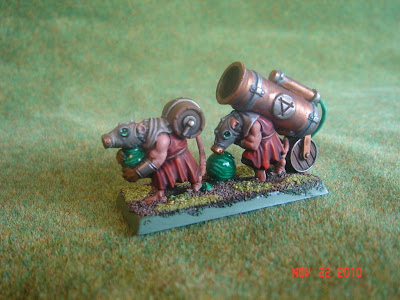Skaven Poisoned Wind Mortar Step-by-Step painting guide by Squeek Vermintide (@ The chattering horde)
The Poisoned Wind Mortar is another of those crazy Clan Skryre inventions that any self-respecting Warlord just has to love...
Firstly, it seems like it must be almost as lethal to the team using it (and their comrades) as the enemy themselves. Its also easy to mentally picture the two crew nervously loading and firing this thing from the relative safety of (behind) a large unit, all the while worrying about a misfire, a dropped mortar shell or the whole mortar exploding! (I also like to imagine the accompanying Clan Rat unit waiting expectantly to see mortar shells flying over their heads towards the rapidly approaching enemy, only to turn around to find the two operators arguing heatedly about who gets to fire and who gets to load!)
Having posted my Warpfire Thrower guide, I noted that it wouldn't be difficult to quickly throw up a similar guide for the Poisoned Wind Mortar as many of the colours and steps used were the same. While many of the steps and colours below are the same, I still hope that this will prove useful! (More pics below the guide.)
1. Assembly.
- File down or carefully cut away any flash from the model.
- Glue to base.
2. 1st Basing.
- Paint watered-down PVA glue to the base.
- Dip base into modelling sand
- Shake away excess and leave to dry
3. Undercoat.
- Undercoat whole model Chaos Black (I use GW Spray paint.)
4. Drybrush base.
- Calthan Brown.
- Snakebite Leather
5. Basecoat.
Apply base colours to all parts of the model.
- Boltgun Metal: Metal bands and pipes on the mortar and backpack containing the poisoned wind globe, rim/ band on support wheel, symbol on mortar.
- Red Gore: Robes.
- Tallarn Flesh: Skin, tail etc.
- Dwarf Bronze: Mortar, mortar valve (by operator's hand), gas mask "nose".
- Dark Angels Green: Pipes, Poisoned Wind mortar globes, shard of warpstone by front operator's back foot, gas mask eyes.
- Codex Grey: Weapon team hoods and gas masks.
- Bestial Brown or Calthan Brown: backpack containing poisoned wind globe.
- Snakebite Leather: Leather shoulder straps on backpack, weapon team gloves, belts.
6. Layers.
- Robes: Red Gore/ Blood Red (50/50 Mix), then Red Gore/ Blood Red (25/75 mix) and finally Blood Red.
- Mortar Pipes: Snot Green/ Dark Angels Green 50/50 mix, then Snot Green.
- Warpstone Shard: Snot Green/ Dark Angels Green 50/50 mix.
- Poisoned Wind Globes: Stripe with lines of Snot Green, then a few more lines of Snot Green/ Skull White (75/ 25)
- Gas mask eyes: Snot green, then Snot Green/ Skull White mix (50/50). Finally add a tiny spot of white a the top of each eye.
7. Washes.
- Skin, Tail/ Ears, feet: Ogryn Flesh.
- Robes/ Gas mask hoods: Devlan Mud.
- Poison Wind Mortar: Devlan Mud
- Warpstone shard: Thrakka Green
8. Drybrushing.
- Mortar (Bronze parts): Light drybrushing of Dwarf Bronze on edges.
- Mortar (Boltgun Metal parts): Light drybrushing of Chainmail on edges.
9. Highlights.
- Edges of any parts done in Boltgun Metal: Boltgun Metal OR Chainmail.
- Edge of mortar barrel: Chainmail OR Dwarf Bronze as appropriate.
- Skin/ Tail/ Ears: Tallarn Flesh/ Dwarf Flesh (50/50 mix)
10. Verdigris (Optional)
This is the light blue patina that you see on old statues or layers of bronze in museums or exposed to the elements. Having this will add an additional sense of age to any bronze parts. Please note, if you haven't done this before, experiment first, as if you get it wrong this is the last stage of the model, so it may be difficult to correct...
- Heavily water down GW Ice Blue. You'll have to experiment to find the right consistency, but I would say 1 part paint to between 7 and 10 parts water. It should be watery enough that you can wipe away WITHOUT leaving a stain. (Very important so you can correct mistakes if necessary!)
- Carefully paint onto any bronze parts where Verdigris would naturally appear so that it gathers. See "bluish" areas on photos below on the mortar. (recessed areas between bronze parts.)
- Quickly take a tissue, fold to a point, and dab away any excess, so it is left gathered around the parts mentioned above.
- Leave remainder to dry. (Be patient!)
- HINT: Only add Verdigris to one area at a time so you have time to wick or dab away excess before it dries. Don't add to ALL bronze parts on the whole model at the same time! E.g. Do the Bronze top of the mortar, then wipe away. Then do another bit, then wipe away. Then do the... you get the picture!
11. Varnishing (Optional)
I wanted to add a "Glassy" effect to the Poisoned Wind globes to make them stand out (I don't use varnish anywhere else in my army) and because I wasn't happy with the "Gas" effect on the globes themselves. In the end, I think that this very simple use of varnish actually works well and makes the globes really stand out!
- Poisoned Wind Globes: GW 'ardcoat was evenly applied.
- Gas mask eyes: GW 'ardcoat was added to each eye.
12. Final Basing
- Dab on a couple of spots of PVA glue.
- Dip in flock.
- Shake away excess and leave to dry.
Done!









No comments:
Post a Comment